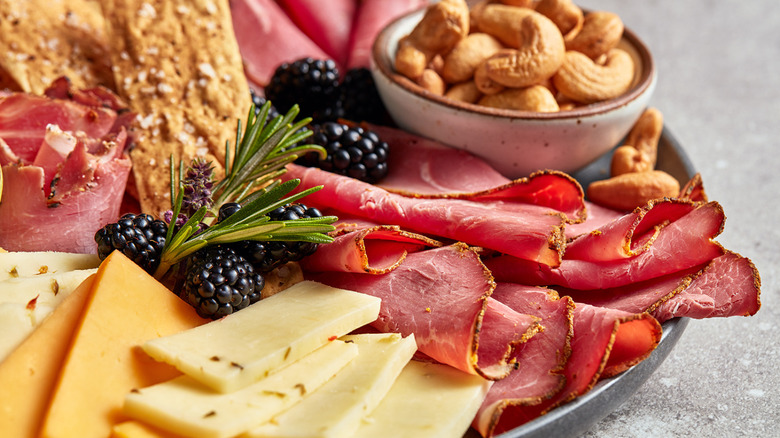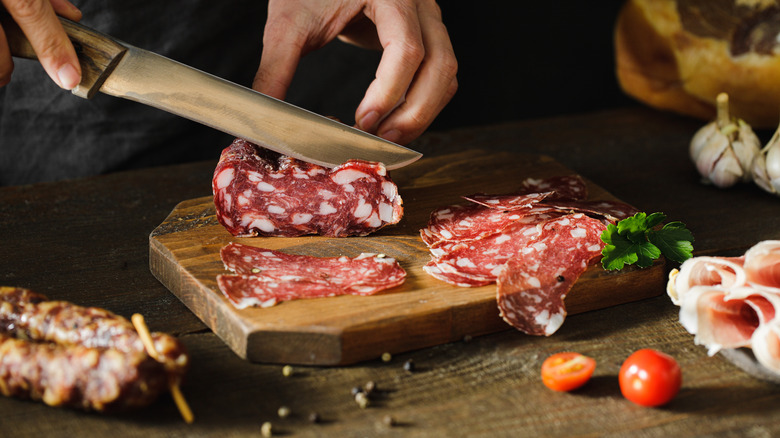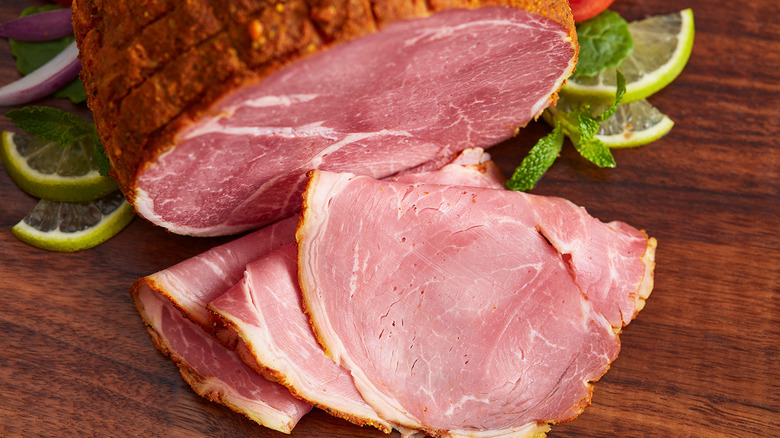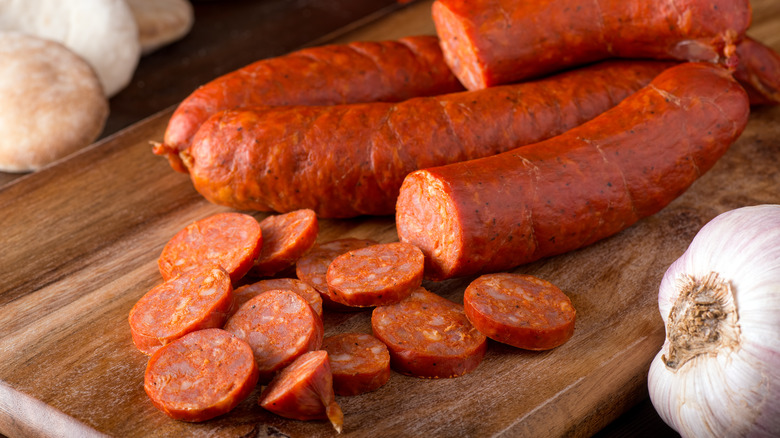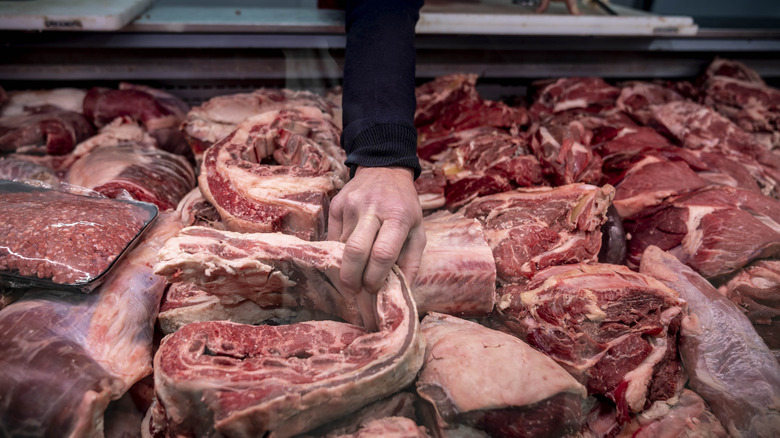The Best Meat For Your Charcuterie Board Isn't One You'd Expect
When muggy summer weather hits its stride, few meals are as satisfying and easy to assemble as a charcuterie board. The French practice of arranging delicately prepared meats is a go-to option for everyone from party planners to solo diners worldwide. And it's easy to see why — after all, who hasn't forged an afternoon snack plate from assorted deli odds and ends? Whether you're more inspired by Lunchables or Lyonnaise cuisine, the possibilities in creating the perfect charcuterie board are limitless.
Charcuterie, by definition, refers to artfully preserved meats, but just about anything goes on modern charcuterie boards. Indeed, even plant-based delicacies like watermelon "ham" have become hits with charcuterie board fanatics in recent years. For omnivores, however, one of the most important elements of a balanced charcuterie board is its meat. Choosing the best meat for your board is a matter of preference, though popular selections generally fall under the spectrum of beef, pork, or poultry. Terrines, confit, and pâte are historically favored in traditional French charcuterie, while contemporary players include everything from jerky to lunchmeat.
Yet there's one unexpected protein that's practically yearning to be the star of your next charcuterie board: lamb. Although you may associate lamb with Sunday roast dinners or shepherd's pie, it has another surprising side. Cured lamb is tender, flavorful, and pairs beautifully with vegetables and cheeses — but most importantly, it shows serious promise as the next big thing in charcuterie.
Why lamb charcuterie is a cut above the rest
Whether you're already a fan of lamb or simply browsing for a new addition to your charcuterie board, cured lamb is the meat you didn't know you were missing. After tasting some of the world's finest fare at the 2023 Summer Fancy Food Show in New York, it was immediately clear that lamb charcuterie stood apart from the crowd the moment I encountered it. In fact, it may have been one of the best bites — let alone prepared meats — that I've ever had.
Warming up to lamb charcuterie could take time for many Americans. Lamb is known for its distinctively grassy undertones, which can sound off-putting to some. However, its earthy flavor mellows in the curing process, taking on a pleasant, almost floral quality that one must savor to believe. Even those who have previously tried lamb and disliked it may be surprised to discover how well it works as charcuterie.
So what makes cured lamb so special? If you've ever tried sumptuous, slow-cooked rillettes, a rich pâté, or melt-in-your-mouth Bayonne ham, you know just how luxurious prepared pork can be. The same can be said for lamb charcuterie. It's visually stunning, remarkably tender and rich, and difficult to stop eating. It carries a strong game flavor, which pairs beautifully with all the salt, and any strong, earthy aromatic components. Lamb is delicious all on its own, but when prepared in the style of ham or pastrami, or more commonly in the form of lamb prosciutto made from the leg, it's simply otherworldly.
Unfortunately, cured lamb is pretty hard to find
Despite how delicious cured lamb is, finding it in the wild can be difficult. The concept of lamb as charcuterie is vastly underrepresented in meat markets nationwide. At the time of writing, only one company in America, Aussie Select, specifically manufactures hand-crafted, ready-to-eat lamb charcuterie. Using pasture-raised lamb imported from Australia, the woman-led company produces a selection of lamb 'ham' in flavors like tikka masala and agave rosemary. But perhaps the most delicious offering from Aussie Select is its deli-style lamb pastrami, which won the Best Alternative Channel Product at the 2021 Prepared Foods Spirit of Innovation Awards shortly after its launch. As a lifelong New York resident and delicatessen enthusiast, I can attest that Aussie Select's pastrami is absolutely worth the hype — and doubly so when topped with horseradish.
Getting your hands on ready-made lamb charcuterie may be a challenge, but it isn't your only option. Fortunately, you can also create your own lamb charcuterie at home. With a little ingenuity, you can transform cuts of lamb into anything your heart desires, from pastrami to prosciutto. And you aren't limited to plain lamb by any means. By adding a simple rub or glaze, you can elevate your homemade lamb charcuterie to new heights. Try experimenting with herbs and spice blends and you'll find that lamb responds beautifully to an array of unexpected flavors.
Other ways to incorporate lamb in your charcuterie board
A truly top-notch charcuterie board should involve a healthy amount of variety to appeal to both the eyes and the palate. While lamb can be an excellent substitute for traditional deli cuts like sliced roast beef or ham, it's also well-suited to other flavors and preservation techniques.
In place of pork-based Italian delicacies, for example, lamb salami provides a unique and savory accompaniment to any charcuterie spread. Luckily, lamb salami is a bit easier to come by than lamb "ham" or deli-style cuts. Foustman's, a San Francisco-based salami manufacturer, creates uncured lamb salami in garlic and rosemary flavors. Lamb salami's unctuousness plays perfectly with other charcuterie board staples, so try it with aged gouda or Arbequina olives.
Lamb sausage is another way to elevate your charcuterie board. For a spicy change of pace, grill up some merguez, a spicy North African lamb sausage often enjoyed with mustard. And if you feel like adding a dose of sweetness to the mix, you can wrap lamb bacon around goat cheese-stuffed dates. You can find lamb bacon from local farms or make your own at home using cured lamb breast or belly from the butcher.
Pairing lamb charcuterie with other menu items
Theoretically, your charcuterie board could consist of meat alone, but grazing is more fun with an assortment of options to mix and match. Mint, mustard, and herb-based sauces are common accompaniments to roast lamb, and these classic flavors can also complement cured lamb. Yet there's no harm in trying something new; after all, part of charcuterie's charm lies in discovering new flavor combinations.
As touched on earlier, lamb salami is delicious alongside a nutty, crystal-studded cheese like aged gouda. But if gouda isn't your thing, try a sweet manchego or salty, mature English cheddar instead. Finding quality European cheese can be tricky when shopping at mainstream grocers, but budget buys like Cornish Cathedral City Cheddar Cheese are good in a pinch. If using a deli-meat style lamb, try serving it with sliced Swiss, some grilled halloumi, or medallions of Bucheron.
For a change of pace, be sure to include some fresh or pickled produce on your board. Olives are a natural choice to add some bite and brininess. While I prefer buttery green varieties, like Castelvetrano olives, lamb can work well with kalamata or black olives, too. If you're keen on pickles, try a spicy pickled mango, gherkins, or a piquant pickle chip, like Wickles, for a garlicky, sweet-and-sour treat. Lastly, don't forget the fruit — black grapes are excellent for cleansing the palate between nibbles of cheese, and figs, raspberries, or cherries all offset lamb's umami qualities nicely.
The need for more lamb in the American meat market
You may be wondering why cured lamb is so scarce in the states these days. Throughout the 1800s, upper-crust Americans clamored for sheep meat of all kinds — it was even popular enough to warrant numerous distribution centers throughout the country. But its popularity waned significantly over time, and beef became America's favorite red meat. Though lamb is a common sight in butcher shops and grocery stores globally, it can prove challenging to find in stateside meat departments. Sheep consumption and production in America has steadily declined since the 1960s, and much of the country's lamb meat comes from major exporters like Australia or New Zealand. As a result, imported lamb can be a touch pricier than beef, depending on your location — but I'd argue it's well worth the cost.
The case for including more lamb in our diets isn't limited to its dynamic flavor profile, either. Commercially-produced American beef is typically grain-fed, whereas lamb is almost always pasture-raised. Compared to beef, lamb meat contains a higher concentration of beneficial nutrients such as conjugated linoleic acid, or CLA, per a study in Meat Science. Additionally, lamb has a higher concentration of omega-3 fatty acids than beef, although its precise composition can vary depending on pasture conditions, reports ScienceDirect.
If history has a way of repeating itself, America is long overdue to rekindle its relationship with lamb. Pasture-fed, sustainably-farmed lamb ticks several boxes that have become increasingly important to consumers, from encouraging healthy forest growth to providing nutrient-dense protein. With any luck, the introduction of lamb charcuterie could revive the popularity of this underutilized meat, providing the deliciousness of lamb in a convenient, ready-to-eat package. If you see it on the menu or find it in stores, don't hesitate to give this hidden gem a try. Like me, you might find you've come across a new favorite meat for your next charcuterie board.
